Alienware 14 vs. Razer Blade 14: What's the Best Portable Gaming Laptop?
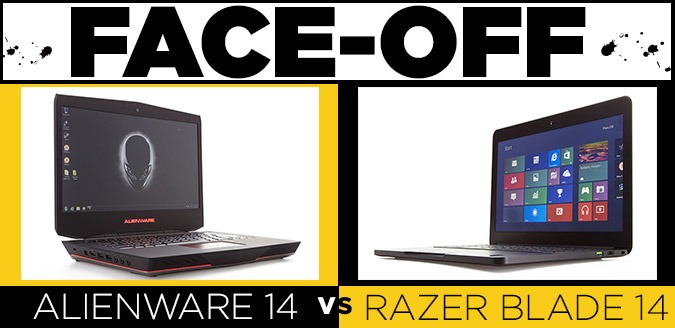
Gamers, lets get ready to rumble! In one corner we have the Razer Blade 14. One of the world’s thinnest gaming notebooks, the Blade 14 (starting price $1,799, $1,999 as reviewed) crams a powerful Intel Core i7 processor and Nvidia graphics with into a lithe frame with over 8 hours of battery life.
In the other corner, we have the Alienware 14 (starting at $1,099, $2,029 as reviewed). Sporting a revamped look, this laptop features a 1080p display, 4th generation Intel Core i7 graphics and Nvidia graphics. There’s also the deep backlighting customization that has become synonymous with the brand.
Though evenly matched, each portable rig has unique strengths and weaknesses that set them apart. To find out which laptop reigns supreme, we pitted these 14-inch titans against each other in a ten round slugfest more epic than a Sephiroth boss battle. Read on to discover which notebook emerged victorious.
MORE: Best Gaming Laptop 2014
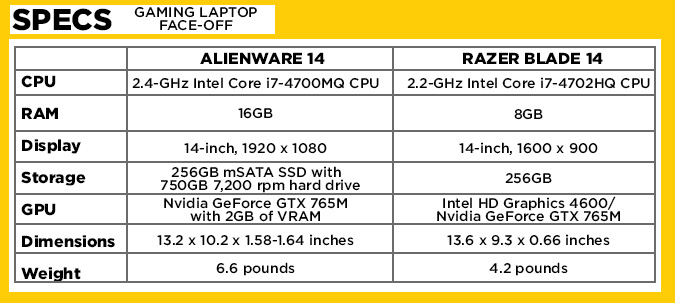
Round 1: Design
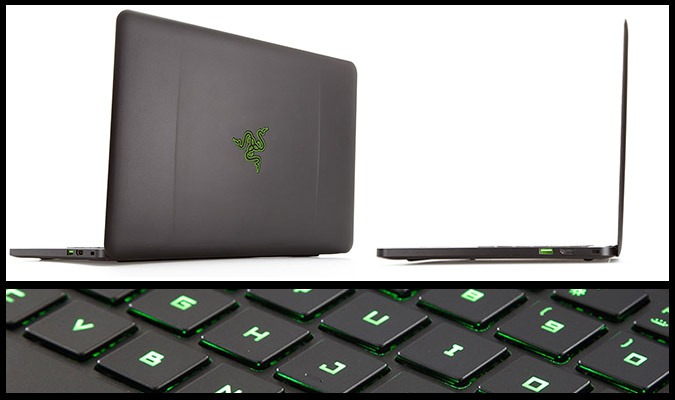
The Razer Blade 14 doesn’t deviate far from the design of its big brother, the Razer Blade Pro. And that’s not a bad thing. It’s hard to find fault with a slick black aluminum chassis that weighs a bag-friendly 4.2 pounds and measures 13.6 x 9.3 x 0.66 inches. Razer’s trademark three-headed green snake logo glows menacingly on the lid. The interior of the notebook serves up more black aluminum with a green backlit keyboard for an overall elegant presentation.
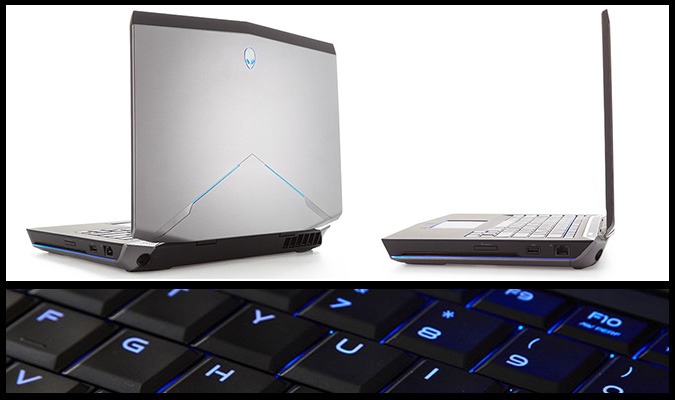
Instead of elegant subtlety, Alienware goes big and flashy. At 6.6 pounds, 13.2 x 10.2 x 157~1.62-inches, the Alienware 14 has considerably more junk in the trunk compared to the Blade 14.
Stay in the know with Laptop Mag
Get our in-depth reviews, helpful tips, great deals, and the biggest news stories delivered to your inbox.
A cross between a spaceship and Tron, the Alienware 14 ditched the lid’s soft touch finish from the previous generation in favor of sleek anodized aluminum scored by thin LED strips. As before, the tell-tale Alien head logo resides near the top of the chassis while a the palm rest and keyboard deck sport a soft-touch finish. In addition to the LED strips, there’s also Alienware’s super-customizable backlit keyboard. The touchpad is also backlit, adding to an already prodigious light show.
Winner: Alienware 14. We’re huge fans of the lightweight portability and sleek looks of the Razer Blade 14, but the Alienware 14 and its gorgeous redesign take this round. Alienware’s new look really brings home that extraterrestrial vibe, while the additional lights make sure that you’ll be the center of attention during a LAN party.
MORE: Gift Ideas for Gamers
Round 2: Display
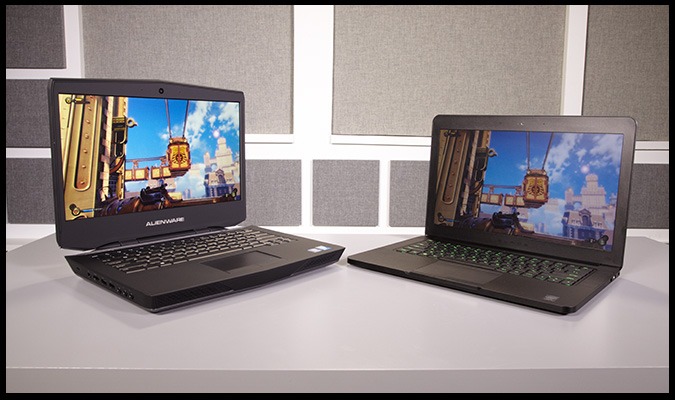
The Alienware 14 has two display options: 1366 x 768 and 1920 x 1080. The Razer Blade 14, by comparison, only comes with a 1600 x 900 screen. During our time with the Alienware 14’s 1080p anti-glare panel, we enjoyed wide viewing angles and with deep rich colors. However, the Blade 14 didn’t quite measure up.
When we viewed an image of a majestic mountain scene on both notebooks, it was no contest. The Alienware 14 delivered lush emerald greens and lovely cerulean skies. The same scene on the Blade 14 looked dull by comparison. The Alienware 14 also had the sharper display, allowing us to see nearly every blade of grass.
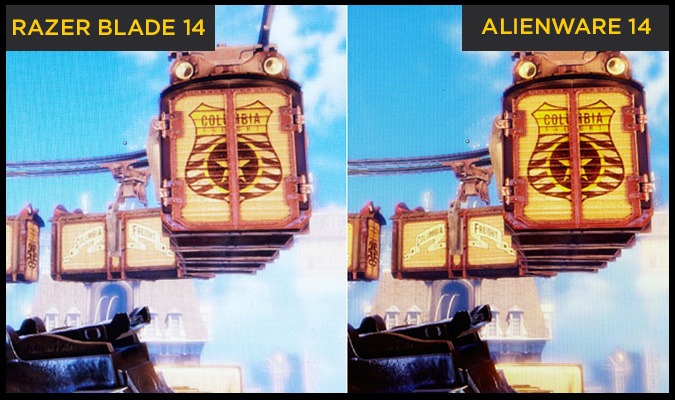
The Alienware 14’s dominance continued in a side-by-side comparison of “BioShock Infinite.” While both notebooks showed off deep reds, greens and blues, the colors were more vibrant on the Alienware 14’s screen. We also saw crisper particle effects on the Alienware 14 including fireworks and gunfire.
However, the Alienware 14’s panel isn’t as bright as we would like. When we measured the brightness, the notebook delivered a measly 161 lux,compared to the 323 lux on the Blade 14.
Winner: Alienware 14. The Blade 14 shines brighter, but the Alienware 14’s 1080p display does an excellent job of delivering more eye-catching color and sharper details.
MORE: 15 Ways to Speed Up Your Boot and Shutdown Times
Round 3: Audio
Big notebook, big sound. Similar to its gargantuan brothers, Alienware 14 packs a pair of Klipsch speakers that offer rich, full audio. Whether we were playing Janelle Monae’s sensual “Primetime” or Ludacris’ bass-driven “My Chick Bad,” the notebook gave us loud and clear sound.
The Blade 14’s pair of Stereo 2.0 speakers and Dolby Home Theater v4 does a respectable job in the audio department. The notebook was able to fill our small test space with loud, relatively clear acoustics.
The Alienware 14 also impressed as we played “BioShock Infinite,” delivering crisp gunfire, swelling strings and effects. Sound was a tad muddier on the Blade 14, leaving the caws from our Murder of Crows vigor sounding muffled against the steady gunfire.
In terms of sheer power, the Alienware notched 92 dB on the Laptop Audio Test (a continuous set tone played 23 inches away from the notebook). The Blade 14 only managed 86 dB.
Winner: Alienware 14. Alienware continues to be the gold standard for gaming notebook audio. Despite its shrunken dimensions, the Alienware 14 packs quite the aural haymaker with clear and booming sound.
Round 4: Keyboard
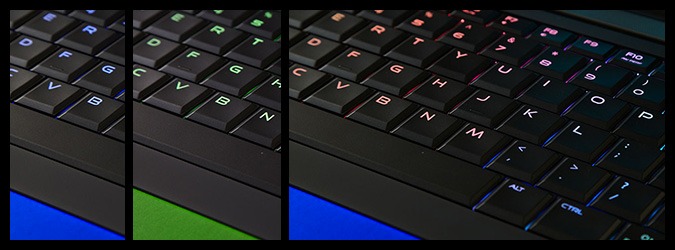
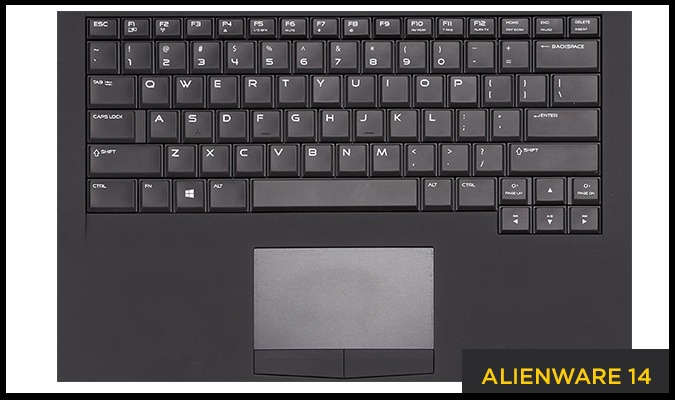
We’d forgive you for humming a few bars of Kanye West’s “All Of The Lights” when you take a gander at the Alienware 14. Similar to previous iterations, the 14-inch notebook features a keyboard with customizable backlighting. Using the company’s AlienFX software, gamers can trick out the lighting on their keyboard, touchpad and various zones around the touchpad. With 20 colors, 3 themes and 10 zones, the customization is deep and captivating.
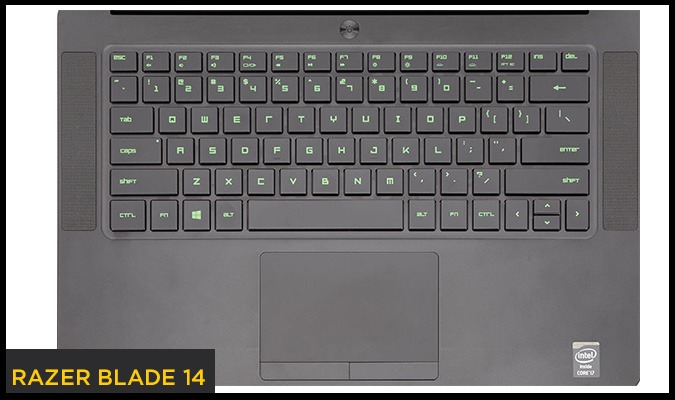
However, when it comes to typing experience, we prefer the Razer Blade 14. The island-style keys provided firmer feedback and deeper travel than the Alienware 14. Thanks to its slimmer profile, the Blade 14’s keyboard is closer to the desk, making for a more comfortable experience. The Alienware 14’s thick deck elevated our wrist into a slightly uncomfortable typing position. And while you can’t change the backlighting color, the Blade 14 is still a great looking keyboard, especially with its distinctive font.
Winner: Razer Blade 14. Alienware has the flash, but Razer has the substance when it comes to the keyboard. A smaller deck, stronger feedback and deeper travel makes typing and gaming on the Razer Blade 14 a smoother, more comfortable experience.
Round 5: Heat
Some like it hot, but not when it comes to notebooks. After 15 minutes of gaming, the Blade 14’s touchpad measured 98 degrees Fahrenheit, several degrees above our 95 degree comfort threshold. The space between the G and H keys and the notebook’s undercarriage got downright toasty, reaching 113 and 125 degrees, respectively.
The Alienware 14’s touchpad was the coolest part on the notebook at 88 degrees. The space between the G and H keys hit 101 degrees while the bottom of the notebook reached 120 degrees. However the rear vent blew a scorching 154 degrees. Even worse are the Alienware 14’s fans, which sound like a small turbine when gaming. The Blade 14’s fans were set to a whisper, allowing for better immersion when gaming.
Winner: Razer Blade 14. Although both notebooks can be hazardous to your lap’s health, the Blade 14 is the cooler of the two and has a quieter fan when gaming.
MORE: Best Laptops 2014
Round 6: Performance
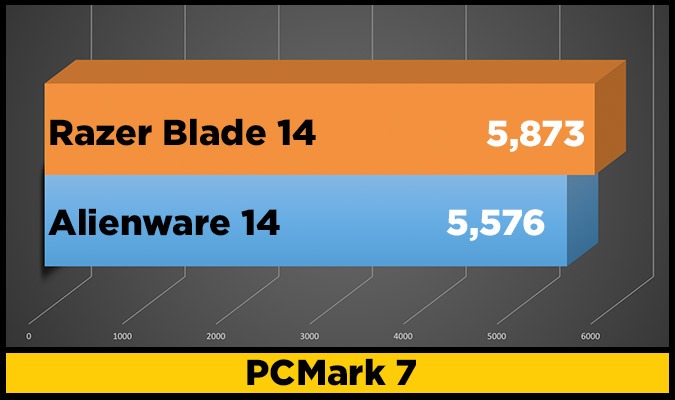
The Blade 14 is proof that a thin frame doesn’t equate to frail performance. Outfitted with a 2.2-GHz Intel Core i7-4702HQ CPU with 8GB of RAM, this gaming notebook notched an impressive 5,873 on the PCMark 7 benchmark. The Alienware 14 and its 2.4-GHz Intel Core i7-4700MQ CPU with 16GB of RAM managed a slightly lower 5,576.
Thanks to its 256GB SSD--and the fact that it was booting Windows 8--the Blade 14 was ready to go in just 7 seconds. The Alienware 14, which has a 750GB 7,200-rpm hard drive and a 256GB mSATA SSD, took 30 seconds to boot Windows 7.
When duplicating 4.97GB of multimedia files on the File Transfer Test, the Alienware 14 had a transfer rate of 221.3MBps, far outpacing the Blade 14’s 141.4MBps.
We ran the OpenOffice Spreadsheet Macro test, which tasked the notebooks with pairing 20,000 names to their corresponding addresses. The Alienware 14 finished in 4 minutes and 5 seconds. The Blade 14 was hot on its heels with a time of 4:15.
Winner: Draw. At the end of our testing, the Alienware 14 and Blade 14 were left in a dead heat, each winning two categories in our performance testing.
Round 7: Graphics
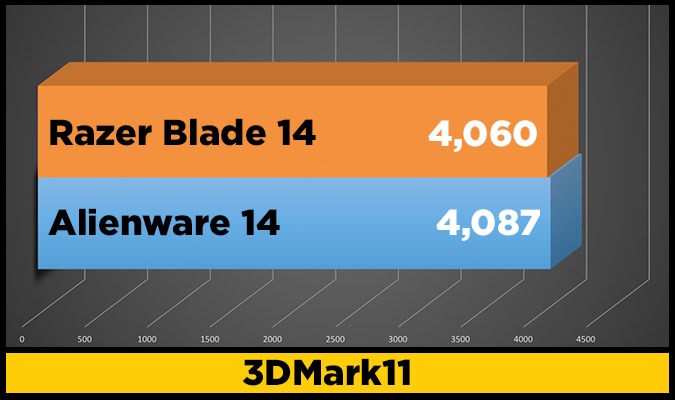
In terms of graphics, the Razer Blade 14 and the Alienware 14 are virtually identical, outfitted with Nvidia GeForce GTX 765M GPU with 2GB of VRAM. When we ran the 3DMark11 benchmark, the Alienware 14 barely edged out the Blade 14, posting 4,087 and 4,060 respectively.
During the “BioShock Infinite” test, the Blade 14 achieved 88 fps at 1600 x 900 on Low while the Alienware 14 delivered 91 fps at 900p. At the game’s highest settings, the Blade 14’s frame rate dropped to 30 fps while the Alienware 14 hit 38 frames.
The Alienware 14 also ran the “Bioshock Infinite” benchmark at 1920 x 1080. The notebook achieved 67 fps on low, which fell to 28 fps at the highest setting. That’s just a couple of frames shy of our 30 fps playability threshold.
Winner: Alienware 14. Despite having the same GPU, the Alienware 14 was able to outperform the Razer Blade 14 on the same games.
MORE: Tech Support Showdown 2013
Round 8: Software
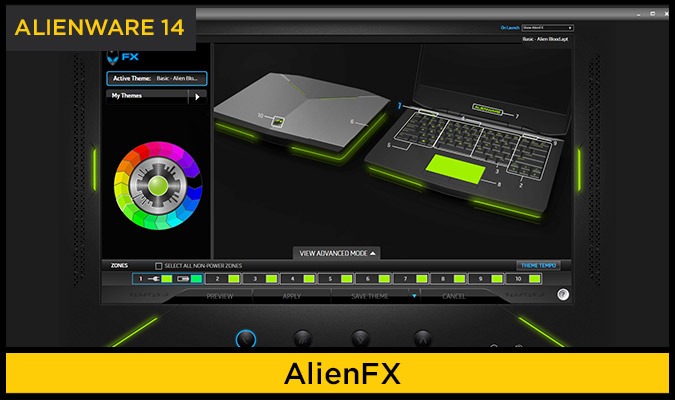
As is its custom, Alienware outfitted the 14 with a modest collection of alien-themed apps. In addition to AlienFX, the lighting customization utility, there's AlienTouch to adjust touchpad sensitivity and Alienware TactX to configure the macro keys.
AlienFusion enables users to create custom power profiles, while AlienAdrenaline creates custom shortcuts that perform a specified set of actions at startup or when a game is launched. AlienAutopsy handles the diagnostic side of things, running scheduled system checks. Last but not least is AlienRespawn, which lets users create backup discs to protect precious data.
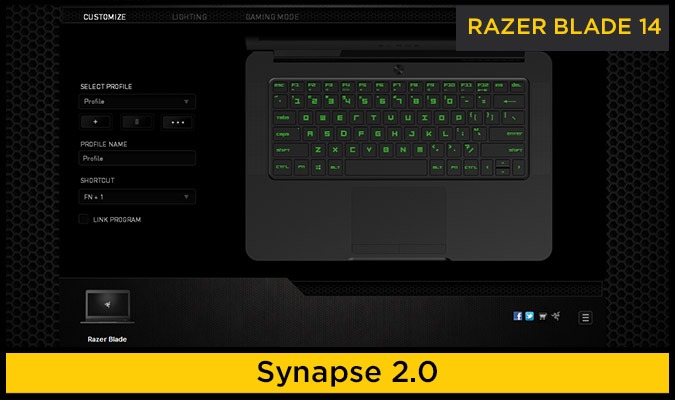
The Razer Blade 14 comes pre-loaded with the company’s cloud-based Synapse 2.0 software. Synapse 2.0 enables users to customize settings, such as mouse sensitivity and keyboard and display brightness. Users can also create profiles for the keyboard, including custom macros. Once created and linked to the corresponding program, the profile automatically launches with the software. Best of all, Synapse 2.0 stores all of your profiles in the cloud, allowing you to switch notebooks and mice without having to recreate all your hard work.
Winner: Razer Blade 14. We found Synapse 2.0 to be the more compelling software, allowing players to streamline in-game functions.
Round 9: Battery Life
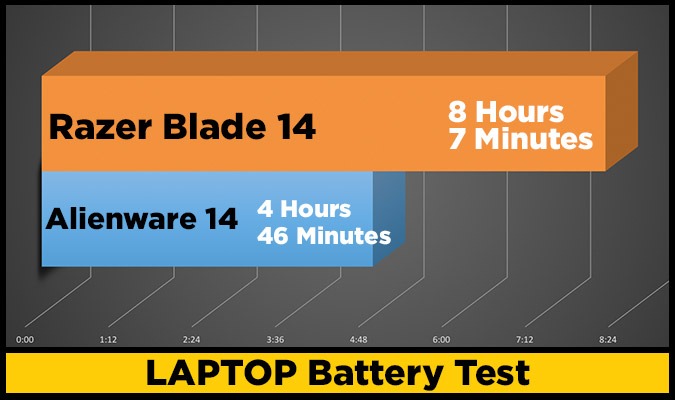
We ran the Laptop Battery Test (continuous web surfing over Wi-Fi) on both the Blade 14 and the Alienware 14. The Blade 14 delivered an impressive 8 hours and 7 minutes, easily outlasting the Alienware 14’s time of 4:46.
Winner: Razer Blade 14. The Razer Blade 14 offers one of the longest runtimes we’ve seen in a gaming notebook.
MORE: 10 Laptops with the Longest Battery Life
Round 10: Value and Configuration Options
Thin doesn’t come cheap. The Razer Blade 14 starts at a wallet draining $1,799 and features a 2.2-GHz Intel Core i7-4702HQ CPU with 8GB of RAM, a 128GB SSD and a Nvidia GeForce GTX 765M GPU with 2GB of VRAM. The $1,999 mid-tier model bumps the storage up to 256GB SSD while the $2,999 model features a 512GB SSD.
The entry-level $1,099 Alienware 14 features a 2.5-GHz Intel Core i5-4200M, 8GB of RAM, a 750GB 7,200-rpm hard drive, a Nvidia GeForce GT 750M with 1 GB of VRAM and a 1366 x 768 display. The $1,249 model offers a 2.4-GHz Intel Core i7-4700MQ CPU and a 1080p display. The $1,849 premium model features a 2.7-GHz Intel Core i7 4800MQ CPU, 16GB of RAM, a 750GB 7,200-rpm hard drive with a Nvidia GeForce GT 750M with 1 GB of VRAM and a 1080p display.
Winner: Alienware 14. Alienware does a great job of keeping its notebooks somewhat affordable. The best configuration of the Alienware 14 is only $100 more than the entry-level Blade 14.
Verdict

It was a close match, but the Alienware 14 emerged triumphant, winning five rounds and tying in one (performance) versus the Razer Blade 14, which secured four rounds.
The Razer Blade 14 offers gamers a truly mobile solution that is sleek and lightweight. Despite its lean looks, Razer found a way to cram an Intel Core i7 processor and discrete Nvidia graphics. The cloud-based Synapse software lets players access their favorite profiles from anywhere. And eight hours of battery life is nothing to sneeze at, either.
The Alienware 14 is ultimately the better value. You get a striking redesign, a sharper and more colorful 1080p display, excellent audio quality, and the lighting customization that fans have come to know and love. Plus, the Alienware offered better gaming performance in our tests. Last but not least, the Alienware 14 has a more budget-friendly price, so gamers can walk away with a respectable set of specs without selling any body parts.
Overall, the Razer Blade 14 is the notebook we’d like to carry, but the Alienware 14 is the one we enjoy gaming on the most.
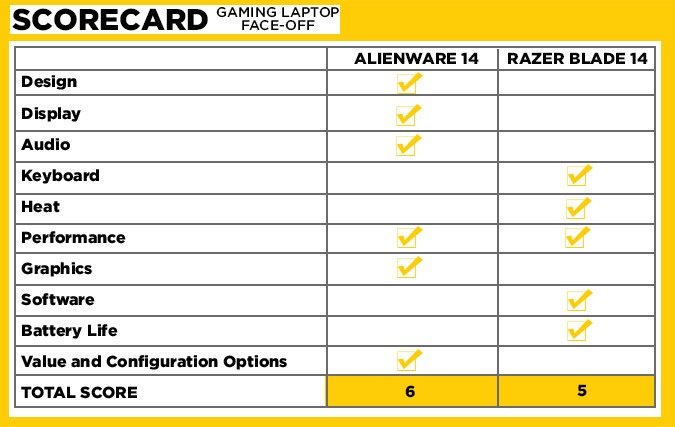

Sherri L. Smith has been cranking out product reviews for Laptopmag.com since 2011. In that time, she's reviewed more than her share of laptops, tablets, smartphones and everything in between. The resident gamer and audio junkie, Sherri was previously a managing editor for Black Web 2.0 and contributed to BET.Com and Popgadget.
